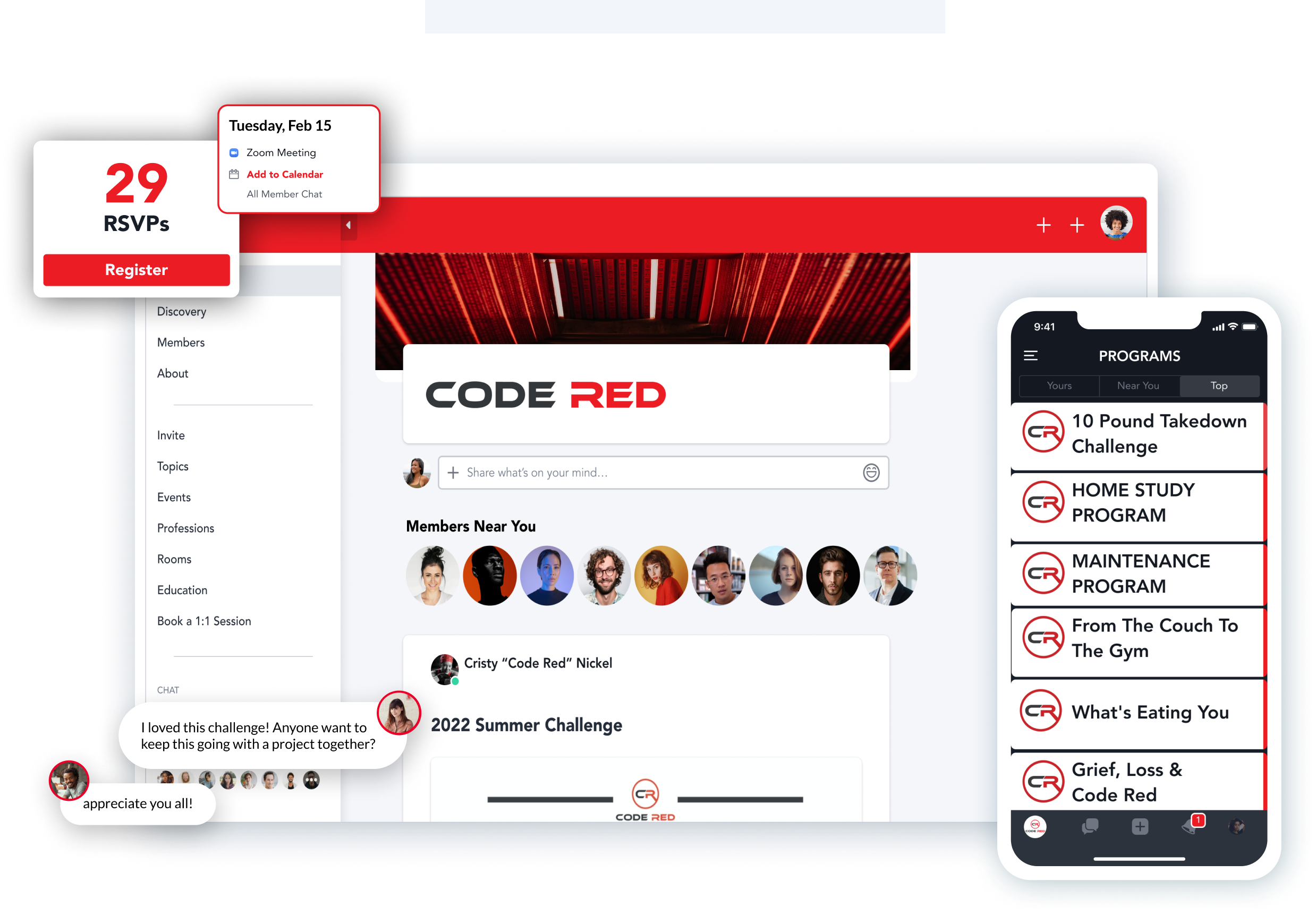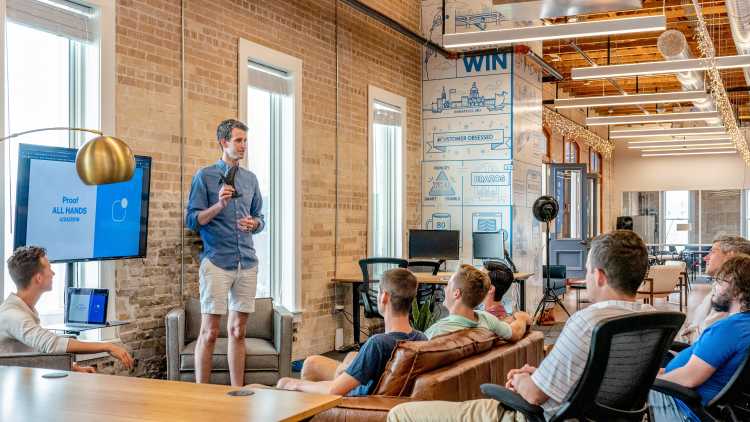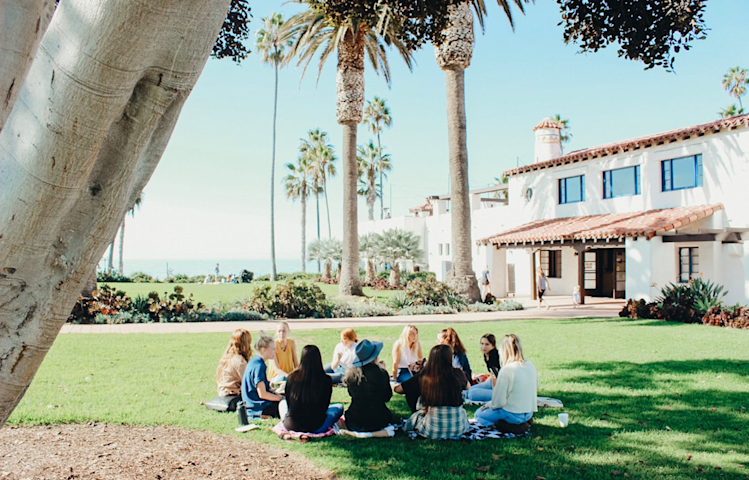Communities & Memberships
The Course Creator’s Guide to Migrating Your Facebook Groups Into Your Own Branded Apps
Tired of running your challenges and communities with cumbersome Facebook Groups? Here’s your exit plan.
Author
Phillip Russell
Last Updated
February 6, 2025

Table of Contents
If you’re a course creator thinking about migrating your community off of Facebook Groups, then you’re in great company.
At Mighty Pro, we've worked with successful course creators, helping them move their communities from Facebook into their own branded membership apps.
The migration away from Facebook and into apps you control means you'll spend less time moderating Facebook comments, you'll get higher retention and contributions from members, and you'll create a much smoother funnel for members to go from joining a challenge group to buying a premium course.
If you’re curious why these course creators made the jump, here are the top reasons they’ve told us:
90% member retention: Communities hosted on Mighty Pro see a 90% monthly member retention rate at an average monthly subscription price of $40/month.
No algorithm to feed endless updates: Hosts who run revenue-generating Mighty Pro Networks post a median of 2-3 times per week.
34% wanted to try out new ideas, like courses, events, and live coaching calls, intimate livestreaming events, and live cohorts and it just wasn’t possible on Facebook.
31% were frustrated that they didn’t own any of their member data, not even their emails.
26% were sick of working so much for free to run their groups and looking for a way to monetize.
If any of this is resonating with you, then you’re ready to make the jump! Ahead, we’re exploring how you can migrate your community off Facebook successfully.
Why should you move your community?
Your members can achieve a whole new level of results and transformation in their lives that they can’t quite find on their own.
After working with thousands of successful course creators, we know that the more focused time they spend with your programs and getting to know other members who are also delving deeper into the topic, the faster everyone progresses on this journey together.
This isn’t aligned with Facebook’s interests. Facebook’s business model is simple: build the best distraction machine possible. It’s designed to get as many people around the globe to spend as much time as possible on its platform, feeding ad inventory to advertisers.
Trying to reach your actual community on Facebook is a lot like trying to have a retreat or a conference in the middle of New York City��’s Times Square. Without focus, there’s no progress. It’s simple: Facebook does not offer focus, even in a private group.
1. You can drastically increase your revenue
If you are anything like the thousands of creators building their brands by bringing people together, you aren’t limiting what’s possible to the constraints of a Facebook Group.
You’ve already made over $100,000 on your online course programs, but there’s always been something off with the platforms you’ve used. It could be that you’re unable to offer a community coupled with your courses in one place. Or that you can’t fully-brand your programs due to the constraints of the platform you’re using.
Maybe you’re attempting to host virtual conferences and events, but the constraints of Facebook’s platform are getting in the way. When you’re using Facebook Groups to bring people together, it all just feels frustrating and disjointed.
Unfortunately, when you anchor on a Facebook Group for your community, the only option for any of these paid or more structured pieces is making do with more and more single feature add-ons that live on different platforms beyond Facebook.
In stark contrast to this mess, when you have your community, online courses, sub-groups, and the ability to charge for any or all parts of your offering together in the same place, something magical happens. Even better, it's available under your brand and across the web and mobile apps.
An example of a successful course creator that migrated her communities off of Facebook Groups and onto Mighty Pro is Christy “Code Red” Nickel's Code Red Community. She is the author of “The Code Red Revolution,” is a speaker, #2 world-ranked boxer (retired), celebrity nutritionist, award-winning personal trainer, and elite-level athlete. She created a nutrition program that enables people to lose 10% of their body weight per month without shakes, diet pills, diet foods, or exercise.

After running a highly successful online coaching program and managing a plethora of Facebook Groups, Christy sought out a place where she could connect all of her communities, courses, virtual events, and more in one place. Migrating off of Facebook Groups was scary, but the decision to do so was a godsend for her business.
She told us a bit about her experience moving her community, “We’ve migrated 20 Facebook Groups into Mighty Pro with 12,500 members joining in the first 30 days. Offering members ONE app for our coaching experiences, livestreaming, and community has changed everything for us.”
As you can see from this example, you can create your own world. With your own rules and culture, all under your branding. Where your content and courses are the priority and available to everyone.
2. You control your brand completely
If your goal is to create a brand that brings people together to master something interesting (and ultimately charge for one or more pieces of your offering), Facebook has a few challenging features:
It doesn’t offer a clear way for your members to get to know each other.
When the main model of interacting with your group is in a person’s newsfeed alongside everything else they have going on, actually building relationships within a Facebook Group is hard.
What we know to be true about truly achieving results and transformation is that it’s more important for your people to see other people following the program and sharing their experiences with one another more than anything your content offers on its own.
It prevents you from reaching all of the members of your own Facebook Group.
It’s challenging to be a mentor to your members if you don’t have confidence that you can reach them. What your members see on Facebook is up to Facebook, not you. And there’s no way for an admin to message all members of a Facebook Group, or even email them.
It isn’t offered under your own brand, on your own terms.
When those same billions of people have been trained that Facebook content and connections are free, how can you differentiate your offering to be something they should pay a premium for when you’re sending your people to multiple platforms–including yet another Facebook Group–none of which are coordinated under your brand?
The most successful course creators realize that owning not only your brand but your space–how you communicate with your members–and knowing that your members will see it is vital to the growth of your business.
Simply put, what we’ve been stressing throughout this guide: If you build your community on an awesome platform, your members will come.
Common mistakes to consider
Now, let’s talk about mistakes. First of all, you’re going to make them. And that’s okay. There are three common mistakes we see successful course creators make when transitioning a Facebook Group. Here’s what we’ve learned from working with thousands of communities, and how (and why) to avoid them:
Mistake #1: Charging a low monthly fee on a new platform when your members have been getting it for free on your Facebook Group.
“It’s been so much work to build and support this community so I’m ready to turn it into a paying gig! I’m going to move my 10,000 member Facebook Group to Mighty and charge $2/month. That’s less than a cup of coffee for my members, but $20,000 a month for me!”
Sound familiar? If only this worked. While this line of reasoning seems to make logical sense, we have yet to see this scenario play out successfully in practice. It has two problems.
First, you’re charging for the thing that they have gotten for free. While people don’t expect all communities will be free, if you’ve been investing heavily in making something awesome that people don’t pay for, they aren’t just going to be willing to pay for it now that you want to start charging.
Second, when you tie paying for something they’ve been getting for free to moving platforms where they already have the expectation that they will have to do more work and learn something new to participate, well, it’s a non-starter.
The good news is the solution is pretty straightforward:
Make sure that you’re creating something new for your most motivated members first. Once you capture them and their excitement on the new platform, then you have a lot more flexibility in where you can take things from here. This is a great time to go to your most active members and try to understand what their challenges are, and where the opportunity might be to better support them.
Make sure that you’ve created something that is different from your free Facebook Group. No one wants to pay for the exact same thing they have been getting for free or can still get for free from someone else in a competing group.
Start with the results and transformation that someone will get from being a part of the new platform. For example, you can focus on the stories and experiences of other people that they can then apply to their own journey to master this topic, or the opportunity to focus and go deep via exclusive events, content, or a course that you’re not offering elsewhere, etc.
Don’t neglect the power and benefits of “going deep” with other members who will now be easier to meet, alongside your time and content.
3. Charge a premium, such as $599 for access to a course or as a year-long membership fee to experiment with payments. While it may seem counterintuitive, you aren’t going to get more people to pay just by making it cheaper.
Rather, you are going to get a set of motivated people who are excited about a new offering, a different offering, where the results of their investment of time and money simply isn’t possible to achieve on Facebook.
Charging a premium tells people that it’s valuable, special, and can only be accomplished somewhere outside the newsfeed whizzing by them day after day on Facebook.
When you follow these steps, there are a number of positive outcomes that makes it a strong alternative to the “low cost/high volume” option that doesn’t tend to work out that well, but there’s one that stands out:
When you create something different for your most motivated members, and you charge a premium for the offering, you don’t need very many people to buy it to make it a success.
Mistake #2: Continuing to run your Facebook Group at full speed while also launching something different on a new platform.
When you are afraid of moving your Facebook Group, one common reaction is to just work harder and take on more responsibility. This often manifests itself in the sense that you need to both continue to run your Facebook Group (or have your moderators run your Facebook Group) just the way it is while also launching something new on a new platform.
This is unnecessary and can lead to burnout.
Here’s a better approach. It’s absolutely appropriate as you are transitioning to a new chapter for your community for you to pull back from your Facebook Group and invest more heavily in a new, more holistic, more integrated offering.
You can even keep your Facebook Group open as you make your move. That’s up to you. You can always create the boundary for yourself, your moderators, and your most motivated members that says, “we’re going to invest where people can get the best results, off Facebook, while still telling people about it, on Facebook.
Mistake #3: Paying more attention to the people who don’t want to move, instead of those who are excited about the transition.
It’s too easy to focus on the small handful of people who want to keep things the way they are, even if those things aren’t leveling up the community as a whole.
Focus on the things that you can uniquely do on the new platform, for the people who are excited to be there, and follow “the bright spots”—the successes, the positive feedback, and the unexpected surprises—to evolve what you’re doing into something even stronger than what you started.
The Logistics
Let’s start with the data, your community and purpose are unique, but your journey is well trodded. Here’s what we learned from many course creators who’ve made the move from Facebook to their Mighty Pro branded apps, specifically, and what it means for you:
52% of them moved a standalone community, while 38% moved a course and a community. So if you’re thinking about moving your Facebook Group but you also have a course on Kajabi, Teachable, or Thinkific, this guide is perfectly applicable to your situation as well.
68% were running their Facebook Group for 3 years or less—20% for less than a year. You don’t have to “stick it out” on Facebook for years to see if you can make it work. In fact, we commonly hear from Group admins that they wish they’d made the move earlier.
But don’t worry, it’s never too late to move. 8% of Hosts who migrated a Facebook Group were running it for over 7 years!
There’s no audience size “sweet spot” that tells you when to migrate.
The majority of successful course creators who moved a Facebook Group had members in the hundreds, but almost 20% had thousands, even hundreds of thousands of members.
The work for your migration doesn’t scale as your member count does, and the success of your Mighty Network isn’t dependent on having a Facebook Group of millions before you make the change.
You don’t have to have a plan to keep both communities active and running.
In fact, 75% of Hosts who moved their Facebook Group stopped using the old one and 33% shut it down entirely. Once you move forward, you don’t need to keep looking back.
Sharing your move to a new platform
The good news for moving your community off a Facebook Group is that there’s a concrete announcement formula that you can make your own. Here it is:
The good news for moving your community off a Facebook Group is that there’s a concrete announcement formula that you can make your own. Here it is:
DAY 21: Reach out individually to a crew
DAY 14: Announce your community through a series of one to eight posts or emails.
SHARE DAY: Live event
DAY +1: Start your first 90 days
We teach this announcement formula in our Community Design™ Accelerator and have used it ourselves for years. It’s simple:
1. Three weeks before you are ready to make your move, reach out individually to “a crew.”
You don’t have to orchestrate your move alone. By bringing a small team together upfront—you don’t need more than two to three folks to build a crew— you’ll learn the questions you’ll get around the move faster, and have more people committed to the shift on announcement day.
If you have existing moderators or admins, use them. Otherwise, reach out to of your most dedicated or motivated members. Share the move with them, why you’re excited about it, how it will be different, and ask for their help.
2. Two weeks before you’re ready to make your move, announce your new plan. After trying a few different time frames–both longer and shorter–two weeks ends up being just about enough time to convince people that change is coming and it’s going to be awesome. Longer and people won’t think you’re serious about moving. Shorter and they will feel rushed.
During these two weeks, put your new community–including your Mighty Network–in an open “Coming Soon” state. There are a few things you can set up ahead of your Share Day event—like adding prompts for members to introducethemselves or share what they are most excited about in moving to your community’s next chapter. Use your Mighty Checklist in your Mighty Network to get just enough activity populated to remind people to come back for your Share Day.
One more thing. When you announce your new plan, make sure that you include a “frequently asked questions” post and let people know that you’ll be paying attention to questions asked on a single post, not necessarily responding to every single post they choose to make.
One more thing. When you announce your new plan, make sure that you include a “frequently asked questions” post and let people know that you’ll be paying attention to questions asked on a single post, not necessarily responding to every single post they choose to make.
3. On your “Share Day,” host a live event within your branded app using native livestreaming.
Your “Share Day” live event is for the people who have moved over and are now members of the new community or program. Within your Mighty Pro branded apps you can livestream instantenously, allowing all your members to join in and talk with you in a live chatroom.
This is a great moment to revel in the excitement of your new platform and rallying your community around the migration being the right move. It’s a way for people to see who’s here and learn from you where your community is going from here. And if Zoom of Crowdcast is more comfortable for you, Mighty Pro integrates seamlessly with both platforms.
4. Between your initial announcement and your Share Day, publish eight posts or emails dripped out over the course of the two weeks.
This is a “drip” of messaging to highlight the benefits of your new community off Facebook. Sample posts are available at the end of this guide. Make sure to use our special signup link that makes moving from Facebook to Mighty Pro as quick and easy as possible, which you can learn about here in our Help Center.
It will save people a little bit of time, and during this transition, it will feel like a nice touch. If you don’t have email addresses, post directly in your Facebook Group. If you do have email addresses, consider using both posts and email.
5. After your Share Day event, continue to tease new and exciting activity from your new community into your former Facebook Group.
Even if you are planning on deleting your Facebook Group—as opposed to archiving or closing it—give folks a few more weeks after your Share Day event to make the move. You can use this time to get anyone else excited to make the move.
If any of this is making you nervous, do not fear. There’s more support for this move than this guide alone. Specifically, join us in the Community Design™ Accelerator where we’ll help you get started with a plan for your first 90 days.
That’s it. Sharing your community move is easy with this proven formula for announcing and moving your Facebook Group.
After your migration
You can expect around 30% of your members will make the move. This might sound scary, but don’t worry, this is actually okay! Here are a few stats to drive this point home:
Remember, this is all on a wide spectrum—15% of Hosts who moved from Facebook Groups said that between 76-99% of their members came with them, and 6% said that every single member made the transition.
66% of Hosts who migrated from Facebook Groups now charge for courses or memberships. Your commitment to this community becomes so much more sustainable when you’re being paid for your time and energy.
96% of Hosts who migrated a Facebook Group to Mighty would do it again.
Here’s what folks have told us who migrated off of Facebook Groups to Mighty Pro:
- 62% said they’re loving the new product functionality and it’s easier to launch new paid programs, groups, and courses.- 37% said that the quality of their community improved after they moved to Mighty Pro.
While it can be nerve-wracking uprooting the way your business has worked up until this point, migrating your community to Mighty Pro ultimately will allow you much more room to grow, and more control than ever before.
Ready to start building your community?
Start a free 14-day trial to explore Mighty—no credit card required.
More like this
Join Mighty Community
Learn the principles of Community Design™ (and see them in action) alongside thousands of creators and entrepreneurs. It's free to join!

Communities & Memberships
Community Platforms
Managing a Community
Building a Community
Growing a Community
Monetizing a Community
Content Creation
Online Courses
Creating a Course
Teaching a Course
Course Platforms
Selling a Course
Creators & Entrepreneurs
Monetization
Content Creation
Starting a Business
Website Builders
Creating & Managing a Website
Events
Event Platforms
Hosting & Marketing Events
Branded Apps
Creating a Mobile App
Coaching Apps
Community Apps
Coaching
Mastermind Groups
Starting a Coaching Business
Coaching Platforms
Filter by Category
Communities & Memberships
Online Courses
Creators & Entrepreneurs
Events
Branded Apps
Coaching
Build a $1 Million Community
This free masterclass went viral—sign up to learn why.

























